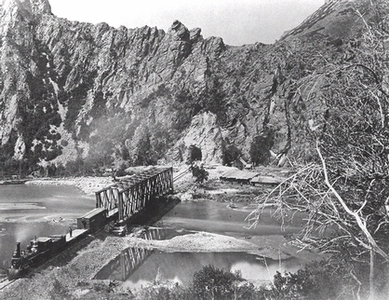Where Did the Union Pacific and Central Pacific Railroads Meet
UNION PACIFIC RAILROAD

Union Pacific bridge and tunnel in Weber Canyon
The Union Pacific Railroad has been an essential link in the transportation network of the West for more than one hundred twenty years. The Union Pacific Railroad was the eastern segment of the first transcontinental railroad completed in 1869. After years of agitation for a railroad link to the Pacific coast, in 1862 the United States Congress authorized such a venture. When the original legislation failed to attract sufficient capital for undertaking the project, a new law was enacted in 1864 doubling the federal land- grant offerings and making generous thirty-year loans for much of the building costs of the road. The Union Pacific Railroad Company was authorized to begin construction from Omaha, Nebraska westward, while the Central Pacific, was to commence building at Sacramento, California and cross the Sierra Nevada Mountains heading eastward. In general, the corporate competition to build the most miles of railroad and thus garner the greater share of land grants and bond money did nothing to enhance the quality of construction.
Nevertheless, each company did an impressive job of meeting their respective obstacles as the project got under way. From the time the Union Pacific began serious work in 1865, the company averaged over a mile a day, accomplished largely through the arduous labor of recently arrived Irish emigrants with picks, shovels and mule-drawn scrapers. Supplying these workmen with the necessities of life gave several men long-lasting reputations as buffalo hunters, and otherwise taxed the ingenuity of the company providers. There were others who inevitably followed the work crews to provide the liquor, feminine companionship and gambling facilities documented in dozens of photographs-the "hell on wheels" that crossed the plains adjacent the construction camps.
As the railroad stretched inexorably westward, it opened portions of Kansas, Nebraska, Colorado and Wyoming to more extensive development. Mining, cattle raising and agricultural activity were generally enhanced by providing more effective transportation of goods to eastern markets. Perhaps no area was more heavily impacted by the Union Pacific than the Intermountain domain settled by members of the Church of Jesus Christ of Latter-day Saints. Brigham Young, leader of these isolated colonists, recognized the advantages and liabilities of the approaching railroad, and unable to stop it, he attempted to make the best of its coming. It would make the large annual emigration of converts from Europe and the East faster, less dangerous and less expensive. And it promised to provide good paying work for numerous Mormon men and draft animals. However, on the other hand, the railroad would bring into the midst of Mormondom all the ills of the outside world Young and his associates had long denounced and abhorred. The coming of the railroad also immeasurably enhanced the profitability of mining in the territory and stimulated a large influx of semi-permanent Gentile residents into the region.
Young arranged with the railroad company for extensive grading contracts through the difficult mountain canyons from Evanston, Wyoming to Ogden, Utah. In the final year of the construction project, Salt Lake City newspapers advertized for anyone wishing employment or subcontracts to apply to Joseph, John W. or Brigham Young Jr., all sons of the church leader. They and Bishop John Sharp worked as intermediaries between the Union Pacific and the local work crews thus recruited. Many of the Mormon workmen were present at the momentous event of the driving of the golden spike on 10 May 1869, celebrating the completion of the transcontinental railroad. However, the church president was absent from the occasion and was represented in official circles by Sharp, who in later years served on the Board of Directors of Union Pacific Railroad.
Brigham Young was unhappy at not being able to persuade either the Union Pacific or Central Pacific to direct the route through Salt Lake City. But soon after completion of the main line, with close and continuing cooperation from Union Pacific, a Mormon-controlled Utah Central Railroad finished a branch line from Ogden to Salt Lake City. For the next generation, southern Utah citizens and mining promoters sought construction of a railroad stretching through the largest region in the United States yet untapped by such transportation facilities, between Salt Lake City and Los Angeles, California. Although many such schemes were projected, none came to fruition, largely because Collis P. Huntington, of Central Pacific and associated railroads, aimed to maintain a monopoly on transportation into California.
The Union Pacific Railroad consistently demonstrated interest in building the Salt Lake and Los Angeles line, and subsidiary companies did gradually extend tracks all the way to the Nevada border, near Caliente. But burdened by scandal, financial depressions and finally bankruptcy, the larger company could not do more at that time. However, after Huntington died in 1900 and independent Montana financier, William A. Clark, began extending the railroad through the Nevada and California deserts, the resurgent Union Pacific, under powerful New Yorker, Edwin H. Harriman, forced Clark to relinquish control and the Salt Lake and Los Angeles line has remained an essential segment of the Union Pacific Railroad ever since.
Where Did the Union Pacific and Central Pacific Railroads Meet
Source: https://www.uen.org/utah_history_encyclopedia/u/UNION_PACIFIC_RAILROAD.shtml
0 Response to "Where Did the Union Pacific and Central Pacific Railroads Meet"
ارسال یک نظر